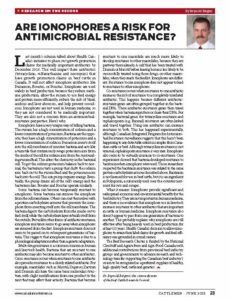Are Ionophores a Risk for Antimicrobial Resistance?
This article written by Dr. Reynold Bergen, BCRC Science Director, originally appeared in the June 2015 issue of Canadian Cattlemen magazine and is reprinted on the BCRC Blog with permission of the publisher.
Last month’s column talked about Health Canada’s initiative to phase out growth promotion claims for medically important antibiotics by December 2016. This will impact three antibiotics (tetracycline, sulfamethazine and neomycin) that have growth promotion claims in beef cattle in Canada. It will not affect ionophore antibiotics like Rumensin, Bovatec, or Posistac. Ionophores are used widely in in beef production because they reduce methane production, allow the rumen to use feed energy and protein more efficiently, reduce the risk of bloat, acidosis and liver abscesses, and help prevent coccidiosis. Ionophores are not used in human medicine, so they are not considered to be medically important. They are also not a concern from an antimicrobial resistance perspective. Here’s why.
Ionophores have a very unique way of killing bacteria. The rumen has a high concentration of sodium and a lower concentration of potassium. Bacteria are the opposite; they have a high concentration of potassium and a lower concentration of sodium. Rumensin inserts itself into the cell membrane of sensitive bacteria and acts like a turnstile that continuously swaps potassium ions from the inside of the cell for sodium ions from the surrounding rumen fluid. This alters the chemistry in the bacterial cell. To get the sodium:potassium balance back to normal, the bacterium starts a pump that shifts the sodium ions back out to the rumen fluid and the potassium ions back into the cell. This ion pump requires energy. Eventually, the pump drains all of the cell’s energy and the bacterium dies. Bovatec and Posistac operate similarly.
Some bacteria can become temporarily resistant to ionophores. Some bacteria can remove the ionophore from the cell membrane. Others can coat themselves with a protein-carbohydrate armor that prevents the ionophores from inserting itself into the cell membrane. The bacteria digests the carbohydrate from the inside out to feed itself, while the carbohydrate layer rebuilds itself from the outside But unlike other forms of antibiotic resistance, ionophore resistance seems to go away when ionophores are removed from the diet. Ionophore resistance does not seem to be passed on to subsequent generations of bacteria. This suggests that ionophore resistance is due to a physiological adaptation rather than a genetic adaptation.
Multi-drug resistance is a common concern in human and livestock health. Bacteria that are resistant to one antibiotic may also become resistant to other antibiotics. Cross-resistance occurs when resistance to one antibiotic also provides resistance to a closely-related antibiotic. For example, macrolides such as Micotil, Zuprevo, Zactran and Draxxin all share the same basic molecular structure, with slight modifications from one product to the next that may affect their activity. Bacteria that become resistant to one macrolide are much more likely to develop resistance to other macrolides, because they are part way there already. A calf that has been treated with Draxxin or Micotil at before leaving home is less likely to be successfully treated using those drugs, or other macrolides, when they reach the feedlot. Ionophores are different. Resistance to one ionophore does not appear to lead to resistance to other ionophores.
Co-resistance occurs when resistance to one antibiotic increases the risk of resistance to a completely unrelated antibiotic. This happens because different antibiotic resistance genes are often grouped together in the bacterial DNA. These antibiotic resistance genes then travel together when bacteria reproduce or share their DNA. For example, bacterial genes for tetracycline resistance and cephalosporin (e.g. Excenel) resistance are often linked and travel together. Using one antibiotic can increase resistance to both. This has happened experimentally, although CIPARS surveillance results suggest that this hasn’t been happening to any detectable extent in samples from Canadian cattle or beef. Although tetracycline resistance is not unusual, cephalosporin resistance is very rare. Ionophores also seem to be virtually immune to co-resistance. One experiment showed that bacteria developed resistance to bacitracin when ionophores were used. Those researchers suspected the bacitracin resistance was related to the same protein-carbohydrate armor described above. Bacitracin is not licensed for use in beef cattle, but it is an ingredient in Polysporin, a commonly-used over-the-counter ointment for cuts and scrapes.
What it Means
Ionophores provide significant and widespread economic and environmental benefits for the beef industry. They are not important in human medicine, and there is no evidence that ionophores use in livestock increases resistance to other antibiotics that are important in cattle or human medicine. Ionophore resistance also doesn’t appear to pass from one generation of bacteria to another. This probably explains why ionophores are still effective after being heavily used in beef production for at least 35 years. Health Canada’s decision to allow ionophores to retain their label claims for growth and feed efficiency was grounded in sound science.
Click here to subscribe to the BCRC Blog and receive email notifications when new content is posted.
The sharing or reprinting of BCRC Blog articles is typically welcome and encouraged, however this article requires permission of the original publisher.
We welcome your questions, comments and suggestions. Contact us directly or generate public discussion by posting your thoughts below.
